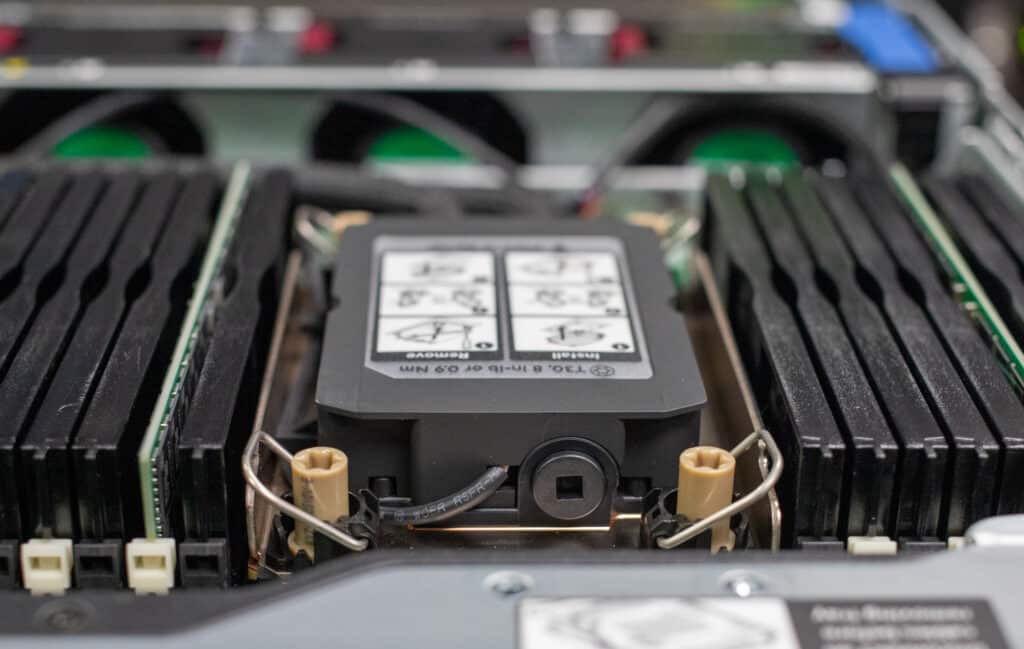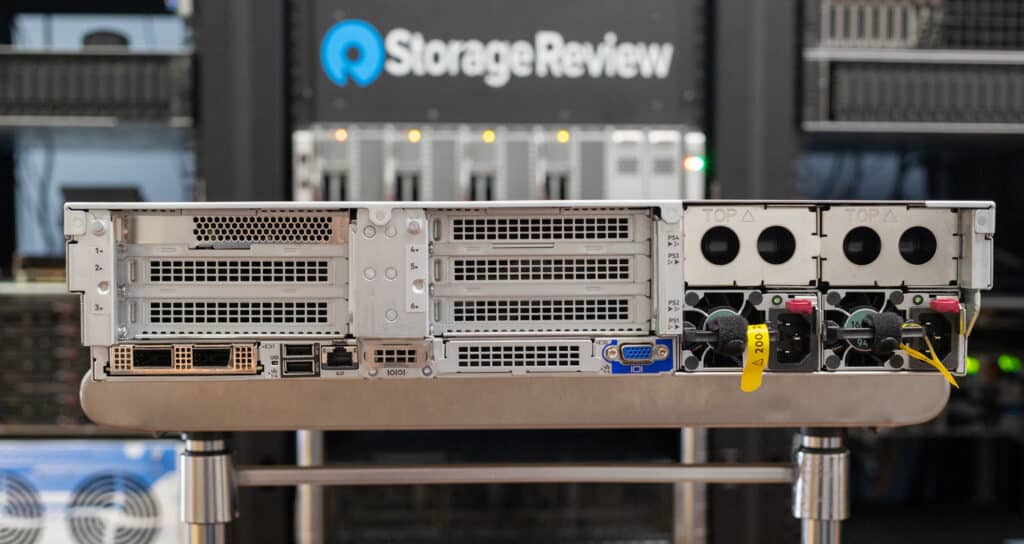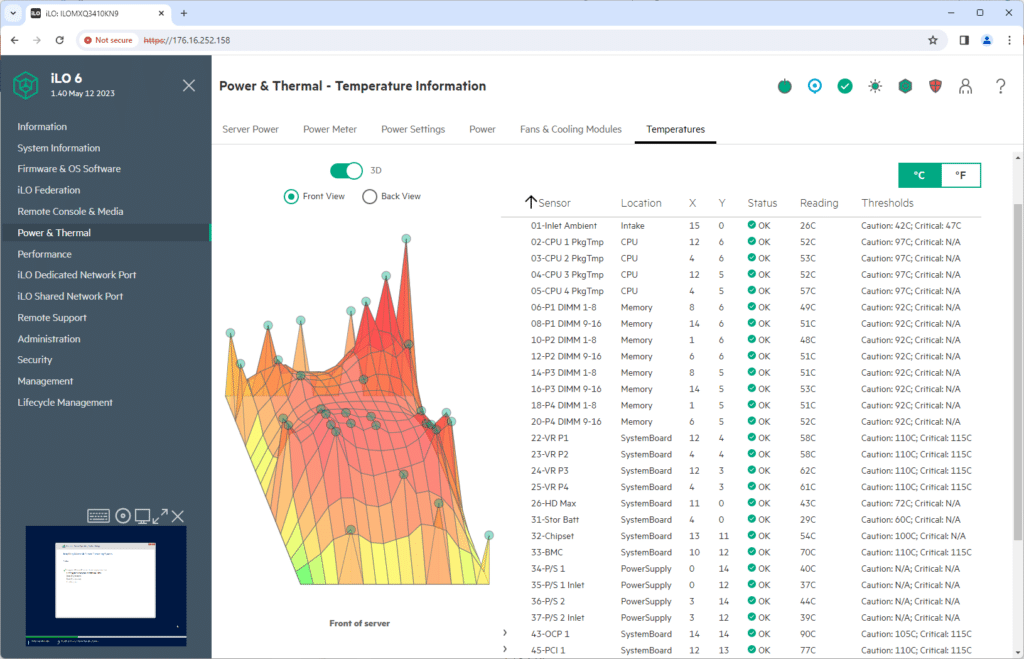The HP ProLiant DL560 Gen11 brings to the forefront the need for enterprises to adapt to modern cooling systems for powerful servers.
If you’ve ever looked at a standard dual-socket 2U server and wished for twice as many CPUs and a massive RAM footprint, the HPE ProLiant Dl560 Gen11 has you covered. This server supports four 4th Gen Intel Xeon Scalable CPUs, up to 16TB of DRAM, and a wide variety of storage and rear-bay expansion. What else is cool? For quad-CPU configurations with a TDP of 270W or higher (per chip), HPE ships a closed-loop liquid cooling to keep those cores operating at peak performance.

Yes. You read that right. This system comes with a closed-loop liquid cooling system for the quad-CPU configuration! How cool is that? (pun intended)
But seriously, HPE has broken the mold with this configuration and made it possible to squeeze all the power and flexibility into a standard 2U frame. What makes it so unique, however, is the stacked setup of the processor boards that allows system administrators relatively easy access to any of the four chips and the ability to bring the liquid cooling systems off with it in one complete package without having to worry about draining or a leaking mess all over the equipment.
HPE ProLiant DL560 Gen11 Hardware
With the cover removed, you can see the two top side processors and their cooling plates, along with the array of RAM slots available, which in our test model is almost empty; however, to ensure proper airflow, it comes with gap fillers.
The closed-loop system traverses from the radiator to the first CPU across the board to the second CPU, then back up to the radiator to cool the now-heated liquid. Underneath is a mirror image of what you see on top.

HPE ProLiant DL560 Gen11 Stacked Radiators
One thing to be keenly aware of is that the liquid cooling system comes with a 5-year warranty, after which the system must be replaced (in full) at the customer’s expense. No part of the cooling system can be worked on or replaced by the customer and must be performed by HPE-certified personnel within the 5-year warranty period.
A closer look at the cooling plates, and like most CPU coolers for high-performance systems, access to the CPU underneath is straightforward, as always.

Liquid Cooling Plate up-close
An up close and personal look at the storage configuration we were provided with. Like most of HPE’s systems coming from their factories, the DL560 Gen11 is highly versatile and can adapted with several different storage controllers and lanes.

Front Storage
Depending on the storage configuration, the backplane will have different combinations of options. Our test system just has one “box” filled, but HPE offers several storage configurations including E3.S SSD backplanes.

Backplane Option, Also Note the Top of the Radiator
The rear of this machine has more than enough space for additional components like GPUs (up to 6!) or NVMe boot drives if that’s your thing. Networking and connectivity are easily accessible and configured in the back.

HPE ProLiant DL560 Gen11 Rear Expansion
Additionally, while our test model didn’t need it, you can see where there is room for four power modules to feed this beast.

Rearview
HPE ProLiant DL560 Gen11 Management
Through iLO, you can look at general information such as processor, memory, network, and storage configurations and the status of each.

iLO Overview
In the Power and Thermal tab, we can see the power reading and power status on the server configuration. Detailed power information is available from the power meter tab. However, that required a paid iLO license, which this system did not include.

iLO Power Information
Next to Power is the Fans & Cooling Modules. This is where you can monitor the Liquid Cooling system. Unfortunately, it only displays the overall status, if the pumps are running, and at what speed.

iLO Liquid Cooling Module
iLO contains a temperature information tab under power and thermal. Based on each temperature sensor on a 3D graph, this information shows you where your hotspots are in the system. Temperature data is essential to keep an eye on to ensure the stability and lifespan of your hardware.

Thermal 3D Graph
HPE ProLiant DL560 Gen11 Specifications
The potential range of specifications of the DL560 Gen11 include:
Processor |
4th Generation Intel® Xeon® Scalable processors that support up to 60 cores |
Memory |
|
Storage Controllers |
|
Drive Bays |
8, 16, or 24 SFF SAS/SATA/NVMe |
Power Supplies |
|
Fans |
Liquid cooling solution, Hot-plug redundant fans, Performance Fan Kit, or High-Performance Fan Kit |
Dimensions |
3.4 x 17.05 x 31.75 in |
Form Factor |
2U rack chassis |
Embedded Management |
|
Server Utilities
|
|
Security |
|
HPE iLO Remote Management Network Port |
1 Gb Dedicated, rear |
Network Options |
None standard. A choice of OCP networking card or stand-up networking card is required. BTO models will come pre-selected with a primary networking card. |
GPU Options |
Up to 6 small GPUs or 2 Large Ones |
USB |
Up to 7 total:
|
Additional Ports |
|
PCIe |
|
Operating System and Hypervisors |
|
Performance
HPE ProLiant DL560 Gen11 Configuration
- 4 x Intel Xeon Platinum 8444H CPUs (16-Core, 2.9GHz)
- 512GB DDR5 (8 x 64GB DDR5-4800)
- Windows Server 2022
We’re comparing it with the recently reviewed DL320, just for scale.
Blackmagic RAW Speed Test
We still run Blackmagic’s RAW speed test, which tests video playback. It’s a good indicator. This is more of a hybrid test that includes CPU and GPU performance for real-world RAW decoding. While there aren’t other HPE machines to show a direct comparison here, to give you an idea of where this one stacks up, other servers generally only output within 50-60fps.
| Blackmagic RAW Speed Test (Higher is better) | HPE ProLiant DL560 Gen11 (Quad Intel Xeon Platinum 8444H , 64 cores, 2.9 GHz) |
HPE ProLiant DL320 (Intel 4th Gen Xeon-G 6430 CPU, 32 cores, 2.1GHz) |
| 8K CPU | 86 | 99 |
| 8K CUDA | N/A | N/A |
Cinebench R23
Maxon’s Cinebench R23 is a CPU rendering benchmark that utilizes all CPU cores and threads. We ran it for both multi- and single-core tests. Higher scores are better.
| Cinebench R23 | HPE ProLiant DL560 Gen11 (Quad Intel Xeon Platinum 8444H , 64 cores, 2.9 GHz) | HPE ProLiant DL320 (Intel 4th Gen Xeon-G 6430 CPU, 32 cores, 2.1GHz) |
| CPU (Multi-Core) (Points) | 83,478 | 38,707 |
| CPU (Single-Core) (Points) | 1,261 | 1,245 |
| MP Ratio | 66.21x | 31.10x |
Cinebench 2024
Maxon’s Cinebench 2024 is a CPU and GPU rendering benchmark that utilizes all CPU cores and threads. We ran it for both multi- and single-core tests. Since this configuration does not have a GPU, we do not have those numbers. Higher scores are better.
| Cinebench 2024 | HPE ProLiant DL560 Gen11 (Quad Intel Xeon Platinum 8444H , 64 cores, 2.9 GHz) | HPE ProLiant DL320 (Intel 4th Gen Xeon-G 6430 CPU, 32 cores, 2.1GHz) |
| CPU (Multi-Core) (Points) | 3,215 | 2,014 |
| CPU (Single-Core) (Points) | 67 | 71 |
| MP Ratio | 48.31x | 28.29x |
Geekbench CPU Benchmark
Geekbench 6 is a cross-platform benchmark that measures overall system performance. However, looking at the single-core vs. multi-core and the OpenCL benchmark would be interesting. Higher scores are better. Again, we only looked at the CPU results, as no GPU is installed inside this server.
You can find comparisons to any system you want in the Geekbench Browser.
| Geekbench 6 | HPE ProLiant DL560 Gen11 (Quad Intel Xeon Platinum 8444H , 64 cores, 2.9 GHz) | HPE ProLiant DL320 (Intel 4th Gen Xeon-G 6430 CPU, 32 cores, 2.1GHz) |
| CPU Benchmark – Single-Core | 3,215 | 2,014 |
| CPU Benchmark – Multi-Core | 67 | 71 |
| GPU Benchmark – OpenCL | 48.31x | 28.29x |
y-cruncher
y-cruncher is a multi-threaded and scalable program that can compute Pi and other mathematical constants to trillions of digits. Since its launch in 2009, it has become a popular benchmarking and stress-testing application for overclockers and hardware enthusiasts.
| y-cruncher (Total Computation time) |
HPE ProLiant DL560 Gen11 (Quad Intel Xeon Platinum 8444H , 64 cores, 2.9 GHz) | HPE ProLiant DL320 (Intel 4th Gen Xeon-G 6430 CPU, 32 cores, 2.1GHz) |
| 1 billion digits (Seconds) | 10.012 | 21.452 |
| 2.5 billion digits (Seconds) | 26.844 | 50.418 |
| 5 billion digits (Seconds) | 56.400 | N/A |
| 10 billion digits (Seconds) | 120.233 | 131.135 |
| 25 billion digits (Seconds) | 340.047 | N/A |
Conclusion
If not already abundantly clear, this system is impressive. The top-end system configs blow the mind with specs like 16TB DRAM, support for six small GPUs or two double-wide ones, and more than enough room for significant storage capacity. The liquid loop is the key that allows for the power and density combo.
While quad-CPU systems aren’t the norm in most data centers, they do continue to offer a very unique value proposition for workloads that can take advantage of the massive DRAM footprint and CPU power. Factor in that this box can take a few GPUs too, and you’d be hard-pressed to find a server that can do more, within 2U of rack space.
The HP ProLiant DL560 Gen11 brings to the forefront the need for enterprises to adapt to modern cooling systems for powerful servers. In this case, we’re dealing with a simple closed-loop system to cool the four CPUs, which handles the need just fine. But as the TDPs creep up in the CPUs and lurch forward in the GPUs, data centers are going to need to be planning for a larger loop or alternative liquid-based systems, there’s no avoiding it. For now, the DL560 Gen11 is a great step forward for dense compute platforms and a worthy consideration for compatible workloads.
Engage with StorageReview
Newsletter | YouTube | Podcast iTunes/Spotify | Instagram | Twitter | TikTok | RSS Feed


